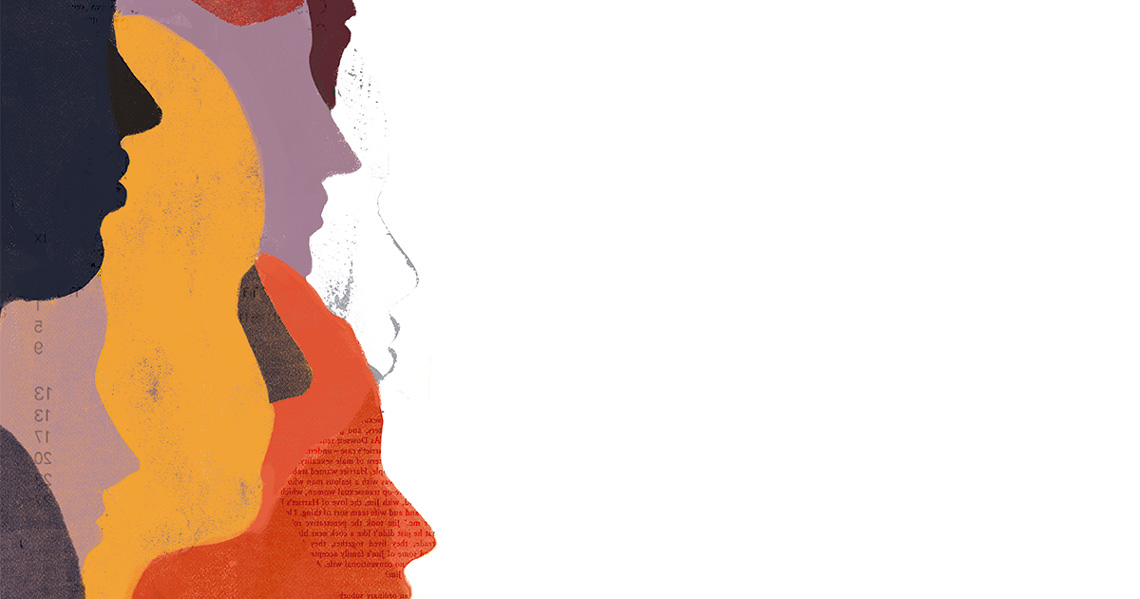An article published in November in the scientific journal Scientometrics presents previously unpublished data on the evolution of studies about the female condition and gender inequalities, a field of interdisciplinary research in which production is growing in Brazil. The paper, a result of librarian Natascha Hoppen’s PhD and also coauthored by her advisor, Samile Vanz, of the Department of Information Sciences at the Federal University of Rio Grande do Sul (UFRGS), analyzed 31,609 articles by Brazilian authors published between 1959 and 2019, collected from academic literature based on a set of frequent keywords in the works.
The result reveals a vigorous trajectory. While the number of papers published about women and gender did not reach more than a dozen per year in the 1960s and 1970s, it reached a total of 3,864 articles in 2018. The analysis has made it possible to observe that such studies gained momentum initially in health sciences, but, at the start of the 1990s, they became the target of interest of human and social sciences and reached a multidisciplinary nature with the emergence of two academic periodicals, the Revista Estudos Feministas, linked to the Institute of Gender Studies at the Federal University of Santa Catarina (UFSC), and the Cadernos Pagu, a periodical linked to the Gender Studies Center of the University of Campinas (UNICAMP).
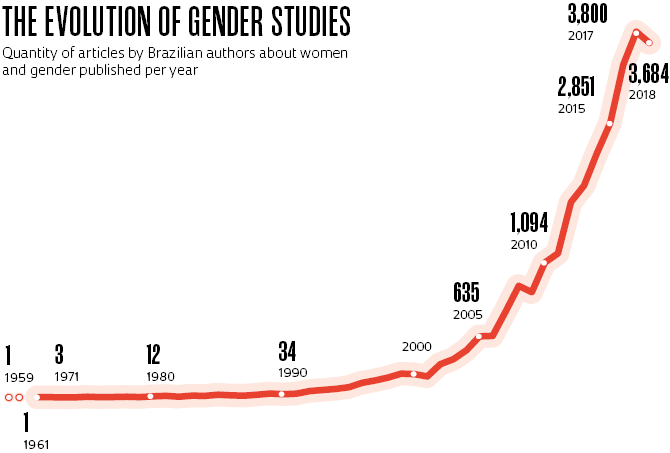
The Brazilian institutions with more significant performance, according to the research, are the University of São Paulo (USP), UFSC, UFRGS, UNICAMP, and the Federal University of Minas Gerais (UFMG). In the private sector, the Pontifical Catholic University of Rio Grande do Sul (PUC-RS) is the highlight. Away from higher education, the Oswaldo Cruz Foundation (FIOCRUZ) stands out in terms of the quantity of articles. Although disseminated widely throughout the country, this production has gaps within the national territory: not a single record of contribution from authors from the states of Amapá, Rondônia, and Roraima was made. São Paulo is the Brazilian state with the oldest and most consistent production, and that collaborates most with other states. Rio Grande do Sul appears in second position in the ranking of the most prolific states—and showed the greatest growth in the past decade.
Overall, human sciences and health sciences share the leadership for volume of papers identified in the study, with 43.97% and 43.44% of the total, respectively. But there are even works in areas such as engineering (0.1% of the total), agricultural sciences (0.09%), and exact and Earth sciences (0.05%). The appearance of this multidisciplinary field in Brazil was linked with the emergence of the civil rights movements, in the 1960s and 1970s, which fought gender inequalities. Despite its origin in academic feminism, the area has developed into a multitude of themes, from the right to abortion to violence against women, from inequalities in the labor market to studies about sexuality, from breastfeeding to family psychology. “Many of these subjects were brought to academia through feminist movements. But one of the levers for the growth of the field of knowledge was the funding obtained in the 1990s, that was aimed at specific themes,” explains Natascha Hoppen, referring to the funding offered, for example, by the Ford Foundation for research into reproductive health and gender.
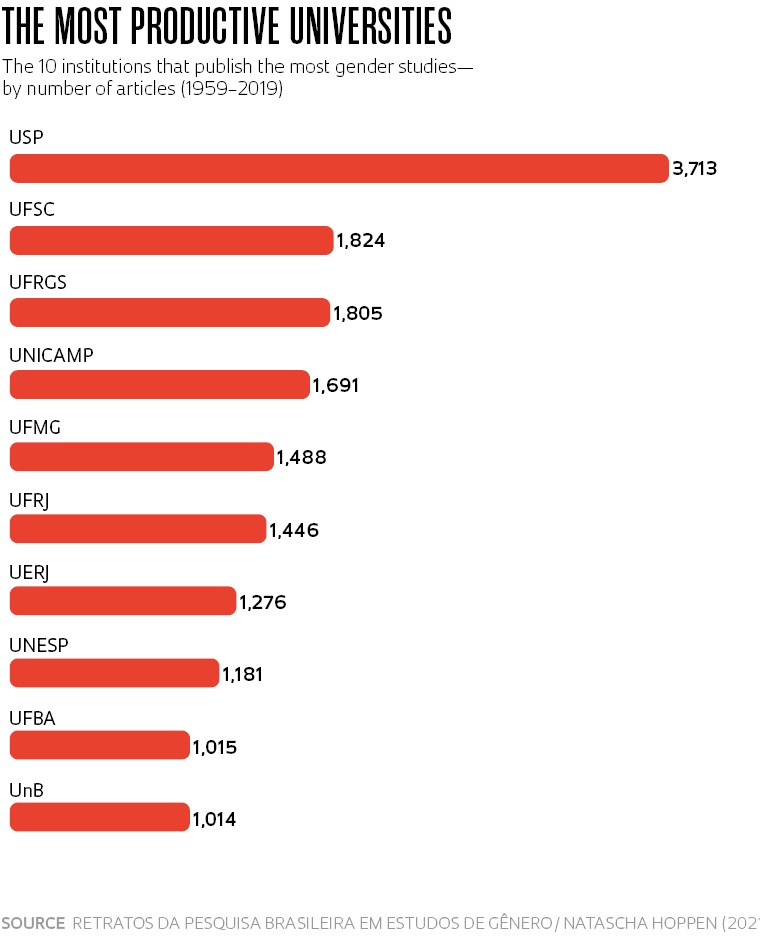
The outburst of new themes is noticed in the periodicals dedicated to gender studies. “We have received articles from authors linked to subjects that rarely appear, such as economics and law, and from new areas, like design and computing,” states historian Cristina Wolff, a teacher at UFSC and editor of the journal Revista Estudos Feministas. “There are subjects that have always been on the agenda of researchers, such as violence against women, the history of the feminist movement, or gender relationships in literature and in cinema,” she affirms. Other themes were already more popular, such as inequality in the labor market. “They end up being substituted by investigations about the role of men and women in the so-called care economy,” she says, with the aim of expanding the demand of society as a result of the populations increased longevity—and the burden that falls on women in this context.
In the works about sexuality, she highlights the emergence of lesbian studies. “Research about trans people has also been appearing, but there are still few works about nonbinary, which I believe should grow in the coming years.” The question of access to abortion is a recurring theme, which would be a reflection of the difficulty of the debate on the issue to evolve in Brazilian society. “While generation of knowledge has managed to help guide public policies in countries like Argentina, with the recent decriminalization of abortion, a wall was built in Brazil to block the discussion and has also had an impact on academic production.”
Dagmar Estermann Meyer, a retired teacher from the School of Education of UFRGS and one of the founders of its Education and Gender Relations Study Group, states that some themes demanded changes of focus and shifts in the area. “Fortunately, the education levels of women, for example, changed for the better in this period. Women, generically speaking, have advanced a lot in terms of education and are already the majority in several areas of expertise. But it is important to remember that for some groups the processes of education are still extremely problematic, as is the case of Black and peripheral youth and trans people, and transvestites,” she observes.
Hoppen recognizes that her study has an important limitation. It so happens that a significant part of production in human sciences is not widespread in scientific articles, but is in books, chapters of books, theses, and dissertations, which were not captured in the study. “I did not find, for example, important works by Lelia Gonzalez [1935–1994]. I later checked that she mainly published in books and in magazines which unfortunately did not migrate to digital format in a way they could be captured in the research,” she says, referring to the anthropologist and researcher from PUC-RJ who was the pioneer of gender inequality studies linked to race—she was the daughter of a Black railroader and an Indigenous maid. One article by Gonzales, “Por um feminismo afrolatinoamericano” (For an Afro-Latin American feminism), was originally published in the magazine ISIS International, in October 1988, which is not available in digital format—it is only possible to access it because it was transformed into a chapter of a book.
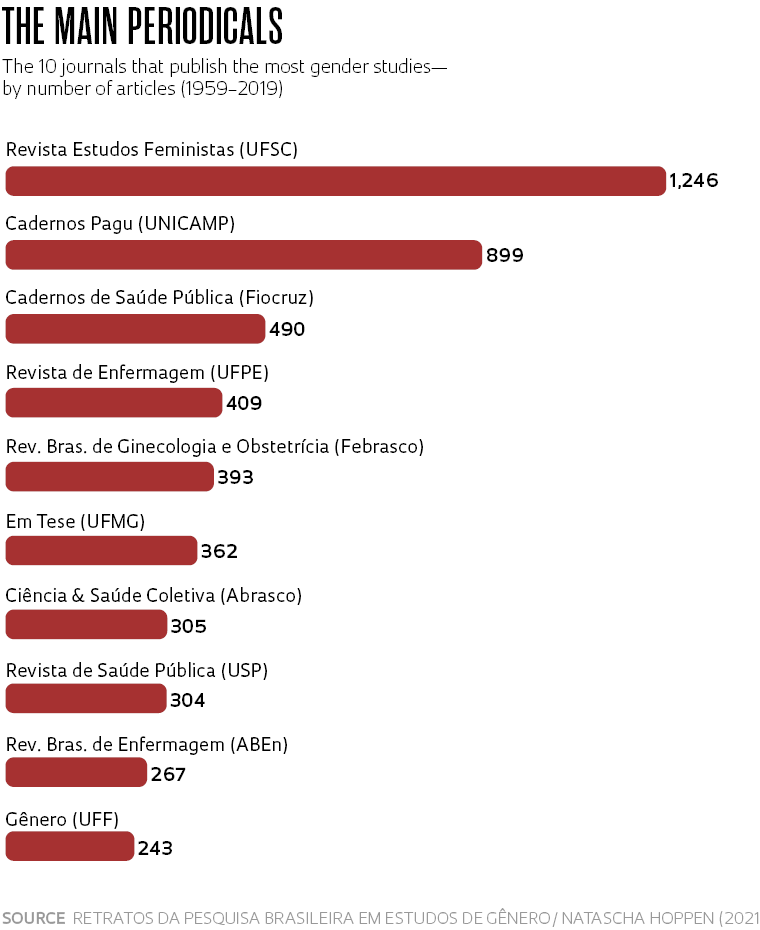
“Similarly, other historical feminists in the field are barely visible in this study. This is because production was mostly concentrated in books and was not very expressive in periodicals during the first two decades covered by the study. The academic times were different and the metric used today to assess scientific production changed a lot in this period,” comments Dagmar Meyer. Despite this problem, she highlights the breadth of the overview outlined by Hoppen. “I don’t know another work in the field of bibliometrics or even a review article that covers such an extensive period or has focused on gender studies in all the main areas of knowledge,” says Meyer, who was one of the examiners on the panel of Hoppen’s PhD, in 2021.
The work tracked scientific production using a tool that is no longer available. It is the 1Findr database, developed to index peer-reviewed magazine articles in all countries and languages, which was bought by the publishing company Elsevier in 2020 and is no longer accessible to the public. “This platform recovered publications from multiple sources, such as the SciELO library and directories of open-access journals from around the world, and it was fundamental for tracking Brazilian research published in the past and written in Portuguese, which is not present in the majority of international databases,” explains Hoppen. The researcher made the raw data from her research available in open access for whoever is interested in studying Brazilian output about gender. “Unfortunately, there is no way of updating it. It would be really interesting to compare the data collected with those related to gender studies in the last four years and see how researchers mobilized during the last government, which had a hostile agenda towards this field of knowledge,” she says.
It is possible that very old articles were not captured by the tool. The first two works associated to gender studies could only be tracked because their printed versions had been digitalized in OCR format, which enables searches of its content to be made online. They are a paper by psychoanalyst Darcy de Mondonça Uchoa (1907–2003), from the São Paulo School of Medicine, published in 1959 in Revista de Neuro-Psiquiatria, which was recovered as it had the word “homosexual” in the abstract, and an article from 1961 by anthropologist and professor at USP Ruy Coelho (1920–1990), which contained the expression “gender studies” among the keywords. “Other printed publications may exist besides these, but which are not visible using the search instruments that exist today,” explains Hoppen.
The works of Uchoa and Coelho are rare examples of what this field of study in Brazil would turn into. The first uses the concept of gender linked to sexual identity to give a pathological connotation to what it considers “deviant behavior.” “This approach is considered totally outdated today,” says the researcher. The second article is an anthropological study, in which gender is used to differentiate social behaviors of two shamans, without going deeper into the theme.
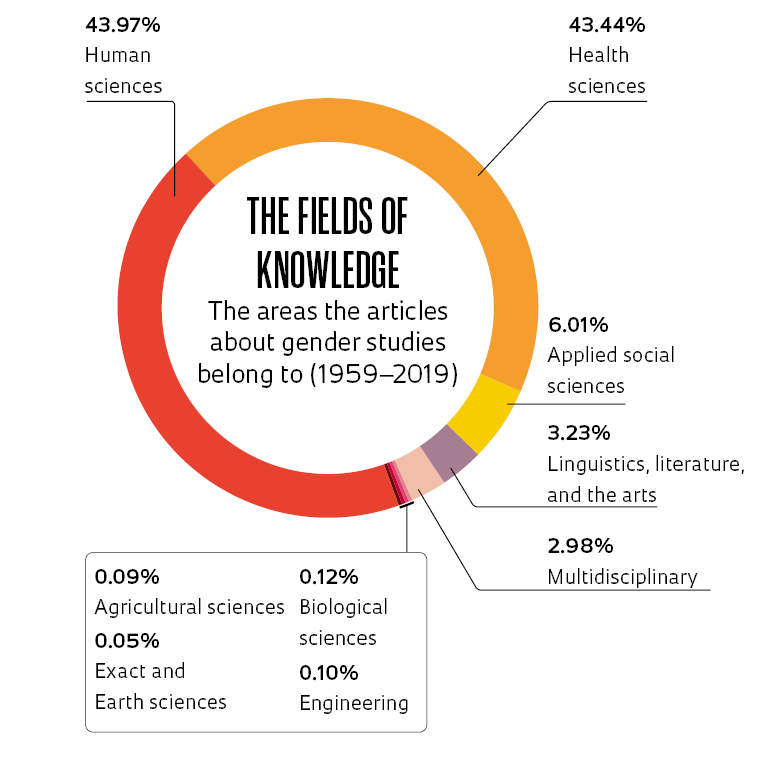
Despite these two pioneering publications, the first marker of scientific production is the associate professorship thesis by Marxist sociologist Heleieth Safiotti (1934–2010), defended in 1967 in the School of Philosophy, Sciences and Languages of Araraquara, which today belongs to São Paulo State University (UNESP). Titled “A mulher na sociedade de classe: mito e realidade” (Women in class society: myth and reality), it was advised by sociologist Florestan Fernandes (1920–1995). The work was published in a book in 1976 and appears in the bibliographical references of a large number of collected articles. Safiotti, a militant feminist, made a marked contribution to themes such as gender violence and women in the labor market.
The article from Scientometrics made other curious findings. One of them was a low willingness among the researchers of gender studies to take part in collaborations. One-third of the publications in the 2010s had a single author, reproducing the pattern of some human science subjects. The formation of partnerships is marked by geographical proximity. Of the articles from the 2010s, 77% have coauthors from the same institution.
On the list of the most prolific authors—those that published more than 20 articles about topics related to gender inequalities and women’s health—the first five names are of men. The champion is psychologist Cesar Augusto Piccinini, a researcher from UFRGS with 108 works on themes such as child and parental psychology. The next two come from the School of Medical Sciences at UNICAMP: obstetricians José Guilherme Cecatti (97 articles) and Aníbal Faúndes (74), both specialists in reproductive health, with research about pregnancy, maternal death, and abortion. Then comes epidemiologist Cesar Victora (69 articles), of the Federal University of Pelotas, an expert on child nutrition and breast feeding, and obstetrician Marcelo Zugaib, of USP (56), with works on pregnancy and maternal health. The first woman appears in sixth place: it is geographer Joseli Maria Silva, of the State University of Ponta Grossa, author of decolonial studies about gender, followed by physician Lilia Schraiber, of USP, with production about violence against women, with 55 and 54 articles, respectively. “A big mark of sexism in science is that women’s health became a field of study considered scientific when it began being researched by men. Female culture and wisdom about their own health was ignored,” affirms Hoppen. According to her, gender inequalities are evident in scientometrics, the field that analyzes quantitative aspects of science. “In most fields of knowledge, men are able to publish more than women and appear to find it easier to publish their research results and do more collaborations. This also appears in the ranking of researchers who publish the most—which corroborates the need for affirmative actions for women in science,” she affirms.
The work did not focus on the content of the articles, but just on keywords. It is possible that a more in-depth verification would not classify some articles as genuine gender studies. “It is common to see works about breastfeeding done by male researchers that don’t locate the challenges imposed on the personal and professional lives of the mothers, which constitute a fundamental concern of feminist studies,” says the researcher.
This type of divergence is not uncommon in gender research. “They are marked by a narrow and necessary articulation between knowledge production and activism and are located within a field of disputes. At the start of the 2000s, for example, it was heavily discussed whether studies about masculinity should be considered within the scope of the field. On the other hand, in my opinion, production by Black female, and above all trans, authors and researchers continues to be underrepresented in the area until today. And because of this, and as the thematic umbrella is broad, it can and always must be contested, enlarged, and updated,” says Dagmar Meyer.
Another difficulty is linked to the interdisciplinary nature of the field. “Although diversity helps strengthen the area, researchers belong to traditional disciplines and are evaluated according to the metrics of these disciplines, which does not favor them,” says Cristina Wolff, who is linked to the Department of History of UFSC and works in its Institute of Gender Studies. “Our graduate courses are requested by students from different areas, but we always have to fight to maintain our space. When one of us retires, there is no guarantee that the substitute will dedicate themselves to gender research,” she says.
Republish

